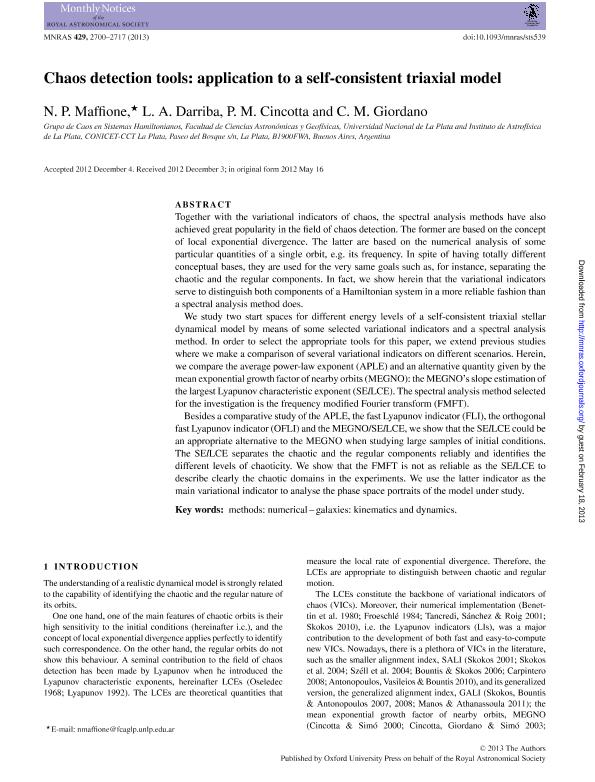Mostrar el registro sencillo del ítem
dc.contributor.author
Maffione, Nicolas Pablo

dc.contributor.author
Darriba, Luciano Ariel

dc.contributor.author
Cincotta, Pablo Miguel

dc.contributor.author
Giordano, Claudia Marcela

dc.date.available
2017-07-07T19:29:18Z
dc.date.issued
2013-03
dc.identifier.citation
Maffione, Nicolas Pablo; Darriba, Luciano Ariel; Cincotta, Pablo Miguel; Giordano, Claudia Marcela; Chaos indicators and a spectral analysis: application to a self-consistent triaxial model; Oxford University Press; Monthly Notices Of The Royal Astronomical Society; 429; 3; 3-2013; 2700-2717
dc.identifier.issn
0035-8711
dc.identifier.uri
http://hdl.handle.net/11336/19874
dc.description.abstract
Together with the variational indicators of chaos, the spectral analysis methods have also achieved great popularity in the field of chaos detection. The former are based on the concept of local exponential divergence. The latter are based on the numerical analysis of some particular quantities of a single orbit, e.g. its frequency. In spite of having totally different conceptual bases, they are used for the very same goals such as, for instance, separating the chaotic and the regular components. In fact, we show herein that the variational indicators serve to distinguish both components of a Hamiltonian system in a more reliable fashion than a spectral analysis method does.
We study two start spaces for different energy levels of a self-consistent triaxial stellar dynamical model by means of some selected variational indicators and a spectral analysis method. In order to select the appropriate tools for this paper, we extend previous studies where we make a comparison of several variational indicators on different scenarios. Herein, we compare the average power-law exponent (APLE) and an alternative quantity given by the mean exponential growth factor of nearby orbits (MEGNO): the MEGNO's slope estimation of the largest Lyapunov characteristic exponent (SElLCE). The spectral analysis method selected for the investigation is the frequency modified Fourier transform (FMFT).
Besides a comparative study of the APLE, the fast Lyapunov indicator (FLI), the orthogonal fast Lyapunov indicator (OFLI) and the MEGNO/SElLCE, we show that the SElLCE could be an appropriate alternative to the MEGNO when studying large samples of initial conditions. The SElLCE separates the chaotic and the regular components reliably and identifies the different levels of chaoticity. We show that the FMFT is not as reliable as the SElLCE to describe clearly the chaotic domains in the experiments. We use the latter indicator as the main variational indicator to analyse the phase space portraits of the model under study.
dc.format
application/pdf
dc.language.iso
eng
dc.publisher
Oxford University Press

dc.rights
info:eu-repo/semantics/openAccess
dc.rights.uri
https://creativecommons.org/licenses/by-nc-sa/2.5/ar/
dc.subject
Numerical Methods
dc.subject
Galaxies
dc.subject
Kinematics
dc.subject
Dynamics
dc.subject.classification
Astronomía

dc.subject.classification
Ciencias Físicas

dc.subject.classification
CIENCIAS NATURALES Y EXACTAS

dc.title
Chaos indicators and a spectral analysis: application to a self-consistent triaxial model
dc.type
info:eu-repo/semantics/article
dc.type
info:ar-repo/semantics/artículo
dc.type
info:eu-repo/semantics/publishedVersion
dc.date.updated
2015-06-02T13:39:55Z
dc.journal.volume
429
dc.journal.number
3
dc.journal.pagination
2700-2717
dc.journal.pais
Reino Unido

dc.journal.ciudad
Londres
dc.description.fil
Fil: Maffione, Nicolas Pablo. Consejo Nacional de Investigaciones Científicas y Técnicas. Centro Científico Tecnológico Conicet - La Plata. Instituto de Astrofísica La Plata. Universidad Nacional de La Plata. Facultad de Ciencias Astronómicas y Geofísicas. Instituto de Astrofísica la Plata; Argentina
dc.description.fil
Fil: Darriba, Luciano Ariel. Consejo Nacional de Investigaciones Científicas y Técnicas. Centro Científico Tecnológico Conicet - La Plata. Instituto de Astrofísica La Plata. Universidad Nacional de La Plata. Facultad de Ciencias Astronómicas y Geofísicas. Instituto de Astrofísica la Plata; Argentina
dc.description.fil
Fil: Cincotta, Pablo Miguel. Consejo Nacional de Investigaciones Científicas y Técnicas. Centro Científico Tecnológico Conicet - La Plata. Instituto de Astrofísica La Plata. Universidad Nacional de La Plata. Facultad de Ciencias Astronómicas y Geofísicas. Instituto de Astrofísica la Plata; Argentina
dc.description.fil
Fil: Giordano, Claudia Marcela. Consejo Nacional de Investigaciones Científicas y Técnicas. Centro Científico Tecnológico Conicet - La Plata. Instituto de Astrofísica La Plata. Universidad Nacional de La Plata. Facultad de Ciencias Astronómicas y Geofísicas. Instituto de Astrofísica la Plata; Argentina
dc.journal.title
Monthly Notices Of The Royal Astronomical Society

dc.relation.alternativeid
info:eu-repo/semantics/altIdentifier/doi/https://doi.org/10.1093/mnras/sts539
dc.relation.alternativeid
info:eu-repo/semantics/altIdentifier/url/https://academic.oup.com/mnras/article-lookup/doi/10.1093/mnras/sts539
Archivos asociados
